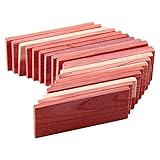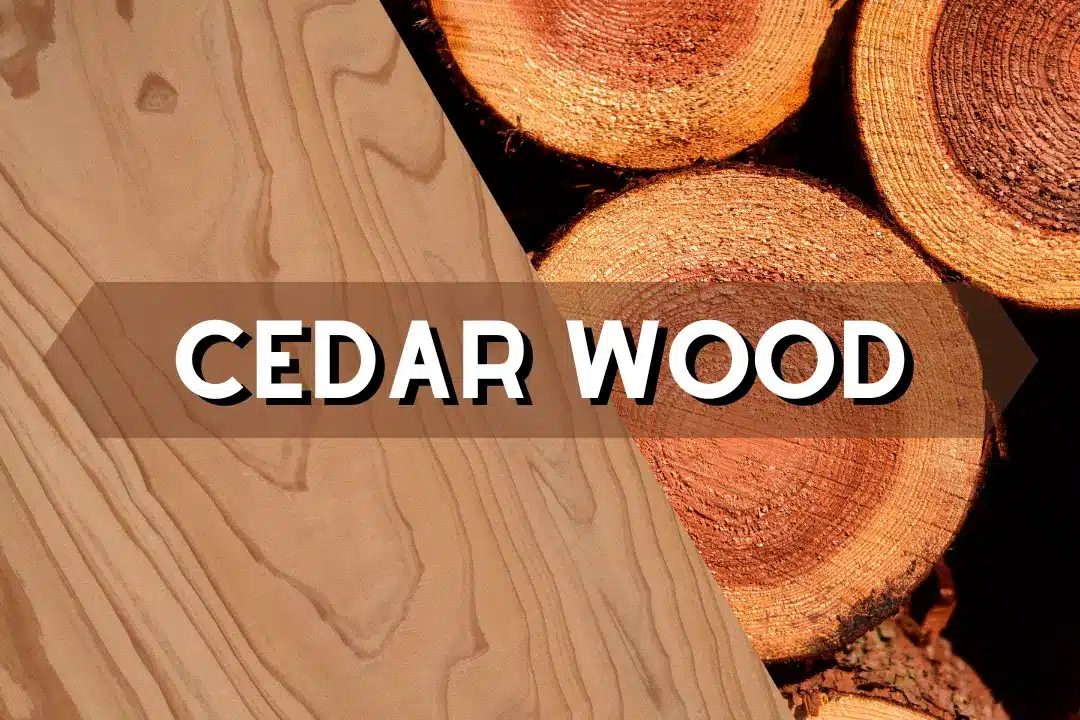
Cedar Wood: Origin, Types and Uses

Did you know the Eastern Red Cedar has a durability rating of 900 on the Janka scale? This shows how strong cedar wood is. But there’s more to it than just its strength.
Cedar wood is known for its beauty and usefulness. It comes from trees like the Inland Red Cedar and Western Red Cedar. These types are popular for outdoor and indoor projects.
When we look into the origin of cedar, its characteristics, and uses, we see its value. Its smell and grain patterns make it a favorite. Knowing its qualities is key for any project.
Table of Contents
What is Cedar Wood?
Cedar wood is loved for its exceptional durability and lovely scent. It’s used in both interior and exterior designs, showing its versatility. Many people find cedar lumber appealing for building and decorating.
This wood is naturally decay-resistant thanks to its oils. This makes it great for outdoor projects like decks and fences. It also keeps pests like termites away.
There are three main types of cedar: Western Red Cedar, Northern White Cedar, and Alaskan Yellow Cedar. Northern White Cedar is more affordable because it grows faster. Alaskan Yellow Cedar is strong and perfect for building boats and bridges.
Cedar wood is also good at keeping temperatures steady. This helps save energy. Cedar siding and roofing can last for decades, making it a smart investment.
The grain patterns and colors of this wood make it beautiful. It’s light, making it easy to work with. This makes it great for custom furniture that adds charm to any room.
Cedar is a cost-effective option compared to exotic hardwoods. It’s also eco-friendly, needs little processing, and is biodegradable. This wood is perfect for many uses, from wall paneling to flooring, because of its beauty and durability.
Definition and Characteristics
Cedarwood includes Western Red Cedar, Eastern Red Cedar, and Alaskan Yellow Cedar. Each type has its strengths, like being strong and lasting long. Eastern Red Cedar, for example, is tough and perfect for outdoor uses like decking and siding.
The wood’s colors range from pinkish-red to deep amber. Cedar wood is softwood, but Spanish Cedar and Yellow Cedar are hardwoods. Sadly, these hardwoods are at risk due to overuse.
Aromatic Properties of Cedar
Cedar wood’s scent is a big reason people love it. The natural oils in it smell fresh and earthy. This scent makes spaces feel welcoming and can even keep bugs away.
As this wood gets older, it turns silver or gray but keeps its smell. This makes it even more appealing for both looks and function.
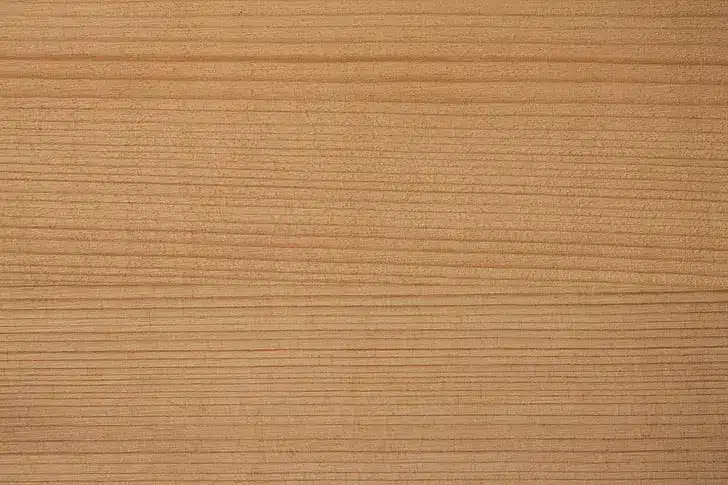
Origin of Cedar Wood
Cedarwood has a rich history that makes it valuable and beautiful. It was highly valued by ancient civilizations for its strength and scent. Cedar was used in building homes, temples, and ships.
It holds deep cultural meaning, symbolizing eternal life and protection. This shows how important cedar trees were to people long ago.
Historical Background
The history of this wood goes back to ancient times, in the Mediterranean and Middle East. Species like the Lebanese cedar and Atlas cedar were highly prized. Egyptians used cedar for big projects because it was so durable.
It was also used in shipbuilding and construction. The Cedar of Lebanon is mentioned in the Bible, showing its importance in building temples.
Geographical Distribution
Cedar trees grow in many places, including the Middle East, Africa, and the Himalayas. In North America, Eastern Red Cedar grows in the east, and Western Red Cedar is found on the Pacific Northwest coast. They need well-drained soil and a mild climate to thrive.
Other notable types include Alaskan Yellow Cedar and Spanish Cedar. These grow in coastal and tropical areas, showing cedar’s adaptability.
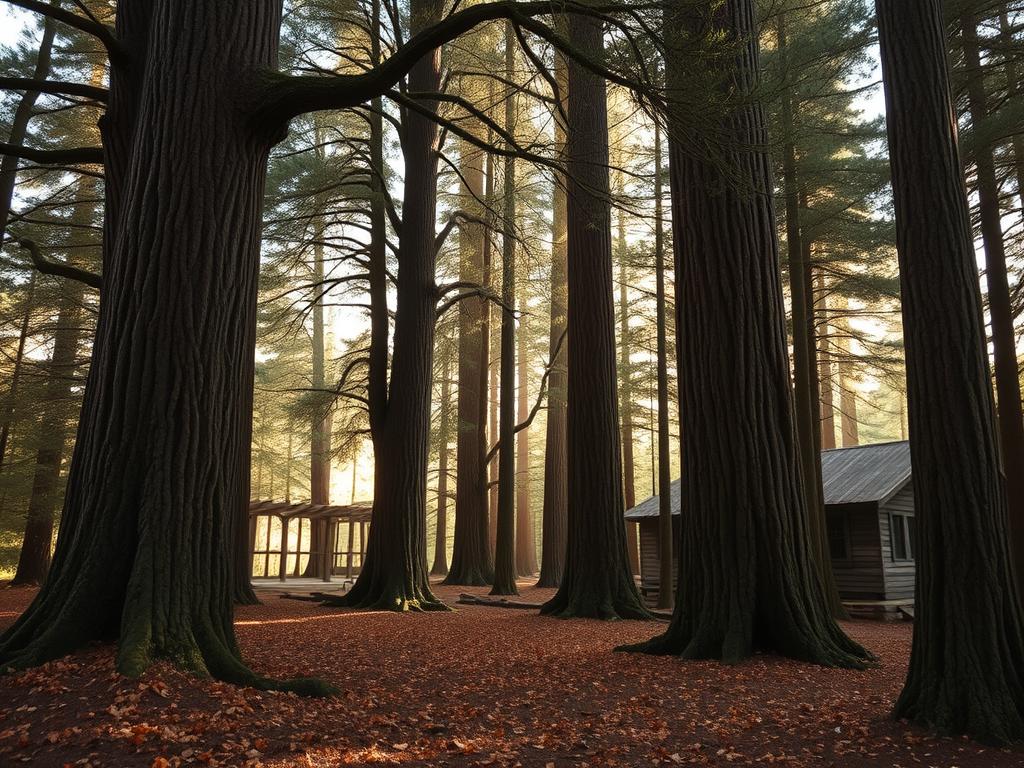
| Species | Regions | Key Uses |
|---|---|---|
| Lebanese Cedar | Middle East | Construction, Shipbuilding |
| Atlas Cedar | North Africa (Morocco) | Furniture Making, Aromatic Oil |
| Eastern Red Cedar | Eastern U.S. | Closets, Crafts |
| Western Red Cedar | Pacific Northwest | Siding, Decking |
| Alaskan Yellow Cedar | Alaska | Musical Instruments |
| Spanish Cedar | South America | Cigars, Cabinetry |
Types of Cedar Wood
It comes in several types, each with its features and uses. Knowing these varieties helps people pick the right wood for their projects.
Western Red Cedar
Western Red Cedar is known for its durability and beautiful colors. It ranges from light amber to deep reddish-brown. This wood can grow up to 200 feet tall and has trunks up to 13 feet wide.
Its light weight makes it easy to work with. This is why it’s often used for outdoor projects like decking and siding.
Eastern Red Cedar
Also called Aromatic Cedar, this type is known for its rustic look. It has a warm reddish-brown color that adds beauty and durability. It’s rated at 900 on the Janka scale.
It’s often used to make decorative items like chests and drawers. Its pleasant scent makes these items even more appealing.
Alaskan Yellow Cedar
Alaskan Yellow Cedar is recognized by its light yellow to golden color. It’s very weather-resistant, making it perfect for coastal areas. It has a high strength-to-weight ratio and grows slowly.
It can grow up to 80 feet tall with a diameter of 35 inches. Its durability makes it great for heavy-duty projects, like boat building and interior paneling.
Spanish Cedar
Spanish Cedar is prized for its rich reddish-brown color and pleasant smell. It has unique Spanish Cedar characteristics that make it perfect for certain uses. It’s often used in cabinetry and millwork.
Its most common use is in cigar boxes and musical instruments. Because it’s vulnerable, it’s important to source it responsibly to protect its forests.
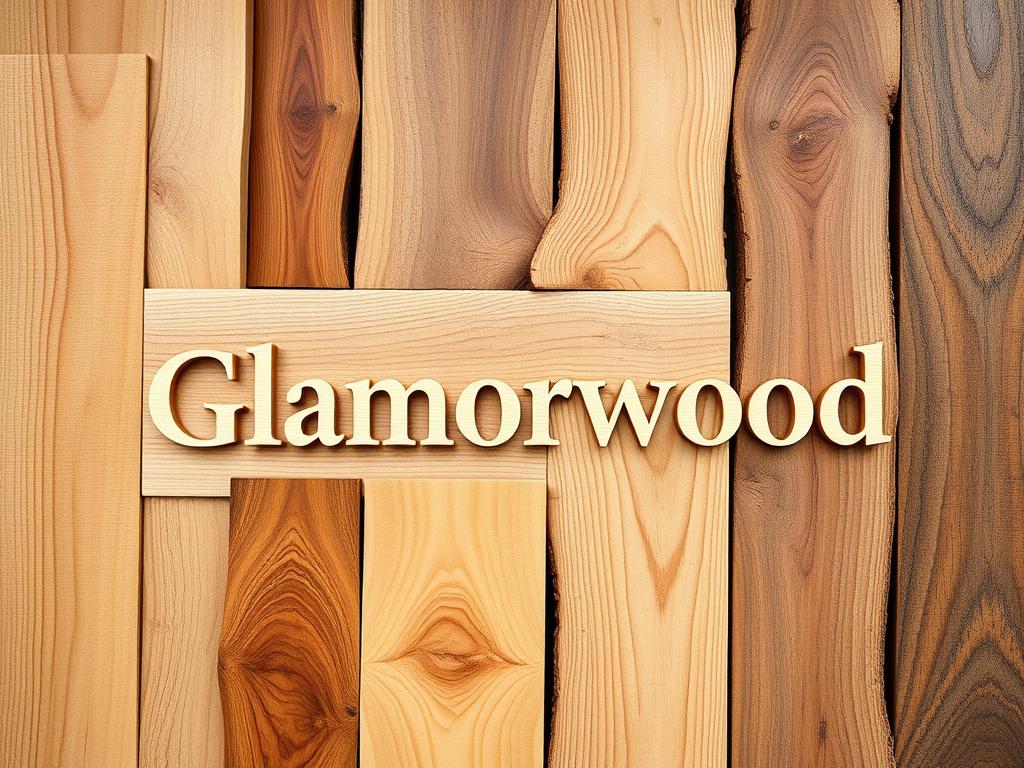
Properties of Cedar Lumber
Cedarwood is known for its amazing qualities. It’s durable, resistant to harsh weather, and has a unique look. These traits make it a top pick for builders and craftspeople.
Durability and Weather Resistance
This wood stands out for its durability. Its natural oils protect it from moisture and decay. This makes it perfect for outdoor use like decking, siding, and fencing.
It can handle tough weather conditions well. This makes cedar a reliable choice for many projects.
Insect Resistance
Cedar wood naturally keeps pests away. Its aromatic oils keep termites and carpenter ants at bay. This means you don’t need to use harmful chemicals.
This natural defense also makes cedar last longer. It’s good for the environment and your wallet.
Color and Grain Patterns
Cedar wood comes in many colors. You can find everything from rich reddish-brown to pale yellow. These colors match many design styles.
The grain patterns of cedar are also varied. They can be fine and straight or interlocked. This adds a special touch to every project. This wood is perfect for both looks and function.
Cedar Wood vs Other Types of Wood
Cedarwood has many benefits that set it apart from other woods. Knowing these differences helps when choosing materials for projects. Here, we compare cedar with juniper, pine, teak, and cypress.
Juniper vs Cedar
Juniper and cedar both have a nice smell and like similar places. Juniper wood is denser and has unique grain patterns. Cedar, on the other hand, is lighter and easier to work with, making it great for building.
These differences mean juniper and cedar are good for different projects.
Cedar vs Pine
Cedar lasts longer and fights off decay and bugs better than pine. Pine is cheaper but doesn’t last as long outdoors. Cedar’s looks and durability make it perfect for outdoor furniture and buildings.
Cedar vs Teak
Teak wood is very weather-resistant and looks golden. But cedar is cheaper and easier to handle. Cedar is often chosen for its cost and sustainability, even though teak has its own benefits.
Cypress vs Cedar
Cypress and cedar both resist moisture and decay well. But cedar has oils that keep bugs away. Cedar is also lighter and easier to work with, making it a top choice for woodworkers.
Common Uses of Cedar Wood
Cedar wood is versatile and popular for both outdoor and indoor uses. It’s durable and resists decay and insects well. This makes it great for many things, from furniture to construction.
Outdoor Applications
Cedar wood is perfect for the outdoors because it can handle the weather. It’s great for:
- Decking and patio areas
- Fencing and privacy screens
- Siding for homes and other structures
- Garden furniture and structures, such as pergolas
Outdoor cedar lumber products last 15-20 years with care. They’re a smart choice for homeowners.
Indoor Applications
Indoors, cedar wood adds beauty and function. It makes spaces look and feel better. It’s used for:
- Furniture, such as chests and wardrobes
- Cabinetry and built-in storage solutions
- Interior paneling and moldings
- Flooring materials
Cedar wood’s scent keeps pests away, like moths. It’s great for storing clothes and decorative chests.
Specialized Uses in Craft and Construction
Cedar lumber is also used in special ways. It’s loved by artists for:
- Musical instruments because of its sound quality
- Custom cabinetry and high-end woodworking
- Craft projects that show off the wood’s beauty and scent
Cedarwood adds a special touch to crafts and complex projects. It’s not just useful; it’s also beautiful.
Considerations When Choosing Cedar Wood
Choosing cedar wood requires careful thought about its quality and how it’s sourced. Knowing the quality of cedar lumber is key for looks and function. Also, choosing sustainable cedar helps protect our environment.
Quality and Sustainability
Quality is key for cedar wood’s performance and life span. Higher grades, like clear vertical grain cedar, last longer and look better. Lower grades might be cheaper but may have flaws that affect how well they work.
It’s important to source cedar wood responsibly. Using wood from certified forests reduces harm to the environment. This choice helps keep natural habitats safe for the future and ensures we have quality cedar for years to come.
Price Variations and Sourcing
The price of cedar wood changes based on type, grade, and demand. Western Red Cedar is often pricier because of its great qualities. But cheaper options like No. 2 cedar can save money for those watching their budget.
Knowing about local lumber markets helps when buying cedar wood. This knowledge helps make choices that fit your project needs and are good for the environment. Talking to experts ensures you get the best cedar for your money.
Conclusion
Cedar wood is a top choice for many reasons. It’s beautiful, durable, and practical. Each type of cedar has its own special qualities, making it perfect for any project.
Western Red Cedar is great for outdoor projects because it’s light. Alaskan Yellow Cedar is strong for heavy tasks. Cedar wood meets both looks and functional needs.
Cedar wood is also good for decking, fencing, and roofing. It fights rot, decay, and bugs well. Inside, it’s used for furniture and insulation, showing its versatility.
Choosing this wood means you get eco-friendly benefits and it’s more affordable than some hardwoods. DIY fans also find it easy to work with. This wood makes spaces look better and last longer.
FAQs
What are the different types of cedar wood and their characteristics?
There are several types of cedar. Western Red Cedar is known for its durability and weather resistance. Eastern Red Cedar has a distinct aromatic quality. Alaskan Yellow Cedar is valued for its light color and strength. Spanish Cedar is recognized for its attractive appearance and scent.
How does cedar wood compare to pine wood?
Cedar is more resistant to decay and insects than pine wood. This makes it better for outdoor use. Pine is cheaper but doesn’t last as long as cedar.
What are the common uses of cedar wood in construction?
Cedar is used for decking, fencing, and siding because it’s weather-resistant. It’s also popular for indoor furniture, cabinetry, and closet linings. Its pleasant aroma can enhance living spaces.
What is the historical significance of cedar wood?
Cedar has been used for thousands of years. It’s valued for its durability and aromatic properties. It was used in homes, temples, and ships. Its importance is reflected in historical texts.
What should I consider when choosing cedar wood for my projects?
When choosing cedar, consider sustainable sourcing. Understand the different types and their properties. Also, be aware of price variations based on species and quality. It’s important to choose responsibly harvested cedar, like Spanish Cedar.
Is cedar suitable for indoor applications?
Yes, cedar lumber is great for indoor use. It has a natural aroma, is durable, and looks good. It’s often used in furniture, cabinetry, and paneling.
How does the aromatic quality of cedar wood benefit its applications?
Cedar wood’s natural oils give it a pleasant aroma. This acts as a natural insect repellent. It’s perfect for closet linings and storage chests. The aroma enhances both functionality and ambiance.
What are the environmental concerns related to cedar wood harvesting?
Some cedar species, like Spanish Cedar, are vulnerable due to overharvesting. It’s important to choose certified wood. This ensures responsible sourcing and supports sustainable forestry.
What are the color variations seen in cedar wood?
Cedar comes in a range of colors, from pale yellow to deep reddish-brown. It has unique grain patterns. These variations add to its beauty and make it suitable for various uses.



